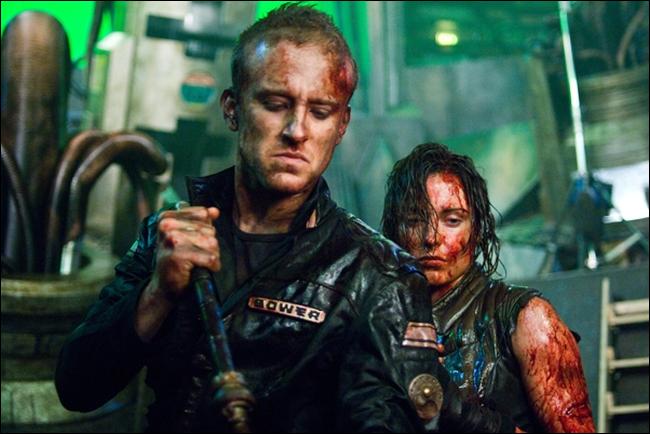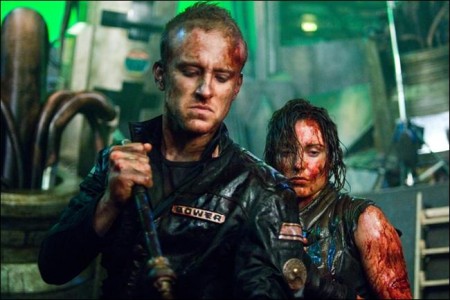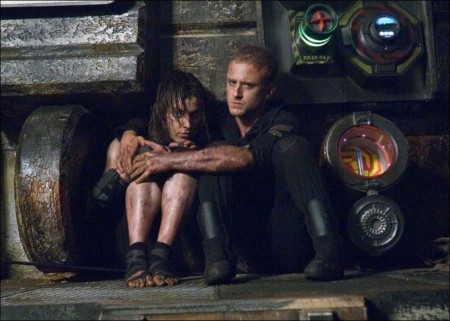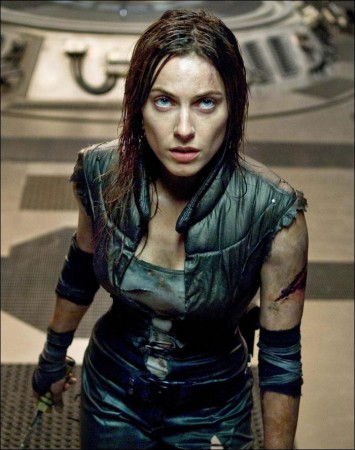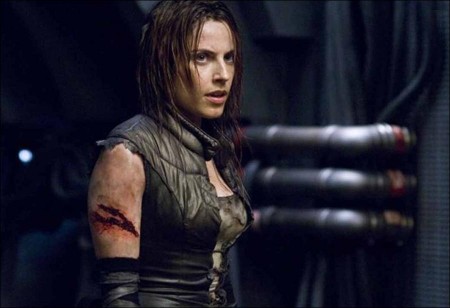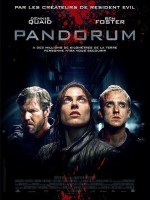“I was always searching for a story that would make me say, `This could be IT,’” says producer Kulzer. “With Pandorum, I got really excited. To have an original movie is a fantastic thing.” Kulzer and his partners knew Pandorum was special.
The original screenplay for Pandorum was written by Travis Milloy. At around the same time he finished writing it, young German director Christian Alvart came to Hollywood after releasing his critically acclaimed cinematic debut, Antibodies.
Alvart began directing at the age of 16, shooting on super-8 with friends while first working for (and later owning) the special interest film magazine X-TRO. With his company, Syrreal Entertainment, he wrote, produced and directed Curiosity & the Cat in 1998, which was followed by the lauded psychological serial killer thriller Antibodies in 2005.
Upon arrival in Hollywood, Alvart himself was working on his own story called No Where, about four astronauts on a long distance space journey who awaken from hyper-sleep without any recollection of their mission’s purpose. “I didn’t think I’d be able to make that film within the next 15 years or so,” says Alvart, “as it was a project on a huge scale and hard to finance.”
After watching Antibodies – a dark and mysterious thriller full of twists and turns – and meeting Christian, producer Bolt thought of Alvart after reading the Pandorum script and sent it to him. “When I started reading,” says Alvart of Milloy’s script, “I was shocked because it shared many elements with my pet project. How could I make my movie if these guys already were making one just like it? “I pitched them my version of the story,” Alvart continues, “No Where merged with Pandorum. I expected to be laughed out of the room.” Instead, the producers got Milloy and Alvart together, and through a rigorous development process, Pandorum emerged. The filmmakers set out to transport the audience into the dark, mysterious depths of space with a scary, thrill-packed film full of smart and bizarre twists.
Although Alvart is a young director, the producers trusted his skills completely. “Christian has all the tools and knows the tricks of this genre – he’s a fan boy and a film scholar,” says producer Kulzer. “He also has a very dark and twisted imagination and he has great ideas.”
Anderson says, “Ever since seeing Christian’s first film I’ve thought him a very talented director. I like his dark, twisted sensibility – definitely something we share in common. He’s brought a completely unique vision to Pandorum.”
Bolt adds, “Christian promised us something wonderfully twisted and fresh and surprising and he delivered. He has a great work ethic and singularity of vision that sets him apart.”
Manning The Flight Crew
Dennis Quaid was the first to join the crew of the spaceship Elysium, taking the part of Lieutenant Payton. Suffering from severe claustrophobia, Quaid’s experienced Payton leads the younger Corporal Bower through the airshaft labyrinth of the spaceship…until the moment he reveals his true character.
In early discussions, says Kulzer, “We said, `It would be great to have someone like Dennis Quaid playing Payton. The fact we actually were able to get him is certainly a high point of my career.” “There are only few actors like him, with such charisma, experience and professionalism,” adds director Alvart, who, anecdotally, knows Quaid’s earlier film Inner Space by heart.
Because of Pandorum’s difficult psychology, it was important to have an actor who would give the audience an instant emotional connection. Quaid fit the bill perfectly – and had a great time doing so. “I’m actually having more fun acting and being a movie star now than I did when I started. I really do – I have the fire in my belly for it,” he laughs.
Quaid’s own interest in space took root when he was a child. “I grew up in Texas, and that’s where the space program started when I was a kid,” he says. “That immediately replaced my wanting to be a cowboy. And I read a lot of authors like Ray Bradbury in the `60s.”
Quaid says, “When I read a script, it’s the only time I get to be an audience member and have a first-time experience of it. When I read this script, it took me on a great ride. Then I met with Christian, who told me how he was going to shoot it, and I wanted to be part of it.
“It’s a thriller,” he continues, “but it’s also a universal story. That’s when these movies really work – when you’re telling a fantastic story. Yes, we’re doing things people can’t relate to, but we’re having human experiences that everyone can relate to – that’s what makes it great.”
Quaid has worked with many great directors throughout his incredible career, but he was very impressed by working with Alvart. “He’s 34, but he performs like a director who’s been doing this for 40 years,” he says. “There’s not a wasted shot in this film, and every shot relates to the spine of the story, to the psychology of the characters.”
As Corporal Bower, Ben Foster plays a mechanical engineer on board the Elysium. Although he lacks complete memory of who he is and why he’s on board, it’s not long before Bower notices the ship is going to break down. Guided by Lieutenant Payton on radio, he makes his way through the shaft system and is confronted with the various horrors the Elysium has in store.
Foster hadn’t previously given much thought to space. “I wanted to go to astronaut camp when I was a kid, but that’s about as far as I’ve considered space,” he says. “I looked at the registration forms and it involved a lot of science and math, and I’m not good at either one of those. I don’t think I’d make good astronaut in real life.”
Fortunately, Pandorum had him hooked. “In general, it’s hard for me getting through a script,” says Foster, “but with this one I was turning pages, like `What’s going to happen next?’ There are so many great twists, it really kept my attention from beginning to end.” He found the very concept of “pandorum” fascinating; he defines it as “a psychological disorder brought on by the claustrophobic experience of being on a spaceship that has the effect of neuroses and delusions of grandeur.”
The way in which the film was shot, takes were short and fast – scenes were covered from all angles in quick filming bursts. Foster found that to be one of the biggest challenges. “There were sometimes 72 or 75 shots for a scene,” he says. “Working within those small pieces and trying to find truth in those is something I haven’t experienced before. But I had a lot of faith in Christian to compose this mosaic of flash images.
“The difficulty is keeping your energy and focus,” he continues. “It’s very abstract. You want to root it in something real, so we were all walking a tightrope trying to find a quality that feels right.”
Of Foster, Alvart says, “Ben is one of my favorite actors in the world. There isn’t any actor out there who could have done a better job.” Adds producer Bolt, “Ben is an amazing actor – very concentrated, very intense.”
For his part, Foster was happy to have an experienced actor like Quaid at his side. “He’s a pro,” Foster says. “He’s good for a laugh, but very focused. He was a great asset to guide me and to make me feel comfortable on set.”
Overall, Foster feels the film will really deliver to anyone who’s ready to have a good time. “There’s definitely a high level of play,” he says. “It’s very dark, it’s psychological, but there’s also a tip of the hat to those classic, fun movies you bring your girl to, have a really good scare and eat a lot of popcorn.”
As the film unfolds and begins to spill its secrets, Bower gains another companion on his nerve-racking journey: Nadia, played by Antje Traue, a young, mostly unknown German actress who won the part over many others who auditioned. After four years of worldwide touring with the hip-hop musical “West End Opera” and smaller parts on German TV and cinema, Pandorum marks Traue’s breakthrough role.
Traue prepared to play Nadia through rigorous training and exercise. “You know when you’re doing something and your body is saying, `No, I don’t want to do that any more – I don’t want to run any more?’ Working out was great preparation for this film because you’re able to go through those moments and have things open up – I worked through a lot of those moments on set, too.”
n shooting the film, another thing Traue had to work through was an apprehension of heights. “I remember Christian came to me and said, `Would you have a problem acting while dealing with heights?’ I said, `No – I think it’s going to be fine.’ But there was ground underneath my feet when I said it. A couple of days later we shot in this old factory and I had to jump over a bridge incredibly high off the ground, and it suddenly hit me: all that’s between me and death are these tiny wires. I had to realize I’m not good with heights at all,” she laughs.
Traue’s Nadia is a scientist onboard the Elysium and, much as on Noah’s Ark, she is responsible for a huge pool of gene material stored in the ship’s biology lab intended to fill a new planet with life. As the film opens, Nadia has been awake for several months, seeking answers and fighting for survival on her own – until she finds Corporal Bower. “Nadia is extremely mistrustful after being alone for so long,” Traue says. “It takes some time for her to gain faith again, but Bower manages to open her up. Then their relationship becomes crucial to their survival.”
Producer Bolt says, “Antje was a discovery. She is intelligent, handles herself physically very well and is believable in a fight – she’s a strong actress with a very distinct style.”
Her co-star Foster agrees. “Antje is one of the treasures of this picture,” he says. “She brings such a humanity and power to her performance.”
Traue enjoyed working so closely with Foster, and was grateful to have him with her on her first big-screen project. “He was at my side, in the movie as well as during the shoot,” she says. “Everything’s been extremely exciting for me. Being a part of it is incredible, and I couldn’t have wished for a better partner than Ben. He’s amazingly creative, very concentrated, and that was very calming for me.”
The onboard crew is also joined by Manh, a Vietnamese agricultural specialist. Manh is played by defending Mixed Martial Arts World Champion Cung Le. “We wanted someone believable as a fighter and warrior,” says Bolt. “Cung is a world champion martial artist who’s embarking on an acting career, so we screen-tested him – and we loved him.”
In March 2008, Le defeated MMA veteran Frank Shamrock in a spectacular fight in San Jose that earned him the title “Strikeforce Middleweight Champion.” Already a master of the ring, acting was a new kind of challenge. After reading the script, Le was ready to do whatever it took to get cast. “I told my manager, `I need a shot. I want to be part of this movie,’” he says. “I was ready to jump through hoops.
“I’m at the highest level in martial arts fighting,” Le continues, “but here I’m just starting to climb the mountain. This is a new kind of energy for me. I’m very honored to be part of Pandorum. “Actually,” he continues with a laugh, “it’s also a lot safer working with actors than being in a cage, fighting with a real fighter. This is actually fun!”
As with everyone else in the story, Le’s Manh has been awake for an indefinite amount of time, exploring the ship and trying to survive. When he first meets Bower and Nadia, their encounter is full of mistrust. “In their first scene, Manh is fighting Nadia,” says Le. “I thought, `I never fought a girl before.’ But hey – whatever it takes to survive.”
Reflecting that gentle side, Le says the biggest challenge for him during filming was being in Germany away from his loved ones. “This was the longest period of time I’d been away from my family, so I was homesick,” he says. “But it’s a job – I’ll do what it takes to get the job done.”
Le loved the experience of filming as well as the cast and crew’s camaraderie on set. “We work with each other very well,” he says. “When the camera started rolling we were in character, but when the camera’s off – we had a blast. We’ve got great chemistry.” He also found comfort in the trust he had in everyone involved in the film. “In anything you do, there is some kind of danger. But here it was safe – you just go out there and take care of business, do what you’re there to do.”
Rounding out the cast is rising star Cam Gigandet, who plays Corporal Gallo, a young officer found by Quaid’s Payton in a very agitated condition.
Gigandet has actually always been frightened by the idea of being in space. “Growing up, I think it was a big fear for me,” he says. “Just the idea of leaving everyone I knew and being so far away, isolated and alone. It’s always scared me.”
Gigandet felt Pandorum was different than anything he’d ever done. “This role was really challenging for me,” he says. “The relationship with Dennis’ character, the type of movie – I knew it was going to be hard, so I had to do it.”
In preparing for his role, Gigandet says it wasn’t the physicality that was most difficult – he’s already very athletic. “They’re obviously officers, so they’re in shape, but the psychological part took the most preparation,” he says. “It’s all about the commitment to what’s actually happening. You have to dig deep and believe the circumstances you’re put into, which is hard. Being in space, having humanity rest on your shoulders, the paranoia, the fear – it took a lot.”
In the film, it quickly becomes apparent there’s an important connection between Gigandet’s Gallo and Quaid’s Payton. “There is something mysterious about me,” Gigandet says of his character, “and something is going on between Payton and me, a weird energy.”
Working so closely with Quaid, he says, “I’ve never worked with anyone that experienced, so the stakes were just raised. It’s a scary thing working with someone who knows what they’re doing,” he laughs. “He’s amazing and funny, but he knows exactly what he’s doing. With so much technical stuff, it was so nice to have someone there who understood what was happening – it was a huge help.”
It doesn’t take long before the Corporal gains his strength and reveals the dark side of his personality…and the horrible truth about the ship’s mission. “The rest you have to see for yourself,” says Gigandet.
Ultimately, the filmmakers were thrilled to assemble such a diverse, talented cast. “It was a lot of effort,” says Anderson,” but it was worth it.
Uncharted Terrority
Filming began on August 11, 2008, in Studio Babelsberg, Potsdam, just outside Berlin. A number of international projects have shot at Babelsberg recently, and the film’s German production connections made it a perfect place for Pandorum to call home.
“We had such a good experience making the first Resident Evil film here,” says Bolt. “There are tremendously good crews here, and Berlin is a fantastic city. Who wouldn’t want to spend 5 months here?”
Director Alvart adds, “I shot Antibodies here, and I loved the crew and people. On a demanding project like Pandorum, I wanted to rely on people I knew.”
In addition, Berlin provided the physical conditions required for the shoot. “We wanted huge sets showing the Elysium’s and the mission’s dimension,” Kulzer says; they wanted a deepness to the locations that would create a vertigo effect. The location was important to the story as well, as the filmmakers wanted the audience to feel the vastness of the ship which in the film can hold up to 60,000 passengers. They found suitable places in the sound stages of Babelsberg and within an abandoned power plant in Berlin, Steglitz, where the last two weeks of shooting took place. “It looks like a spaceship already,” says Alvart. “We just had to add our sets.”
Overall, the production required 54 sets and locations. Production designer Richard Bridgland previously worked with the producers on Resident Evil, and was glad to come onboard for a whole new challenge. Together with Alvart, he created the film’s unique look – a sort of post-industrial futurism.
“This is a well-defined genre, and there’s a typical look to these movies,” says Bridgland. “But this script had a whole different feeling to it, a gothic element I really enjoyed.”
A film like Pandorum can offer huge creative freedom to a production team, but that freedom can make things even more difficult. Alvart says, “You have to solve a paradox every day: You want to believably portray a future nobody knows, yet you want to connect to the audience and make them relate to the characters and story.”
“It had to be very functional,” adds Bridgland. “Things had to work.” The intention – and ultimate result – was to create a look that differs from everything seen before, one that suited the dark and twisted Pandorum. “The sets themselves have to tell the story, so they gradually get more and more gothic and horrifying.”
Of working on set, Foster says, “We’re all affected by environment – emotionally and physically. The sets were designed to provoke a certain experience…and they were very effective in that department.”
Cam Gigandet says, “I expected a lot of green screen, which always makes me skeptical – you can usually see that it’s not real. With Pandorum, it was, `Oh my God, this could all happen.’”
“Digital effects always create a distance – even with today’s technique,” says Kulzer. “We felt the more sets we could actually build and the more realistic they looked, the better the actors could convey real emotions. And the more they get scared, the more the audience will get scared as well.”
The set, which became the actors’ home for three months, together with the fact that some of them had not been to Germany before and could not speak the language, evoked what they ultimately named the “Pandorum effect.” Actor Gigandet says, “The whole situation was quite surreal, and honestly, it brought out insecurity in me.” Foster, who shot each of the 52 production days, says, “The working pace we had, the sets, and the whole atmosphere of the movie certainly supported a feeling of confusion and anxiety.”
Traue adds, “Darkness was a big theme. It was dark when I’d get up, dark when I’d come home, and in between we’re shooting in all dark sets. After some weeks, it definitely had influence on me.” Producer Bolt laughs, “That was all deliberate – disorienting our actors is part of the method.”
The movie’s set design was supported by exceptional camera work and a strong lighting concept created by director of photography Wedigo von Schultzendorff. The film’s look is characterized by an intense interplay of blackness and bright colors like green, blue, yellow and red to emphasize particular situations. “It was definitely a challenge,” von Schultzendorff says. “The movie is set in deep darkness most of the time; I tried to design a more expressionistic distribution of light and create the illusion of darkness.”
Gerd Feuchter, SFX supervisor on Pandorum, says, “Our job was to make the light visible using steam, fog or dust, like a discotheque’s laser show.”
The film’s more exciting scenes are punctuated by spectacular effects work. As with the sets, efforts were made to keep things based in reality, and practical effects were used instead of digital effects whenever possible. Stunt coordinator Francois Doge says, “All the actors were very keen on practicing the stunts, and wanted to do as many as possible by themselves. This is quite rare, especially when the shoot is such a tough one. Honestly, they put heart and soul into this movie.” Ben Foster says, “I suppose it’s the daredevil thing. It’s just fun to jump off something or into something – that’s a boy’s dream.”
With such a complicated shoot, the producers and actors ultimately credit director Alvart and his crew with keeping everyone focused and on task. “The crew is really inspiring,” says Foster. “The rigor and care put into the film is amazing. And Christian is incredible. He had 1500 storyboards – 1500 pictures that he knows inside out! He’s certainly the most visually prepared and focussed director I’ve met.” Altogether about 500 people were engaged to bring the mass of storyboards to life.
The Evil
There’s a negative force that looms over the story and provides Pandorum with its terror, and that evil manifests itself in a variety of ways throughout the film, physically as well as psychologically. The force is evident even in the film’s apocalyptic pre-story, as mankind has destroyed Earth and needs a new place to live. Ben Foster relates to that premise: “The way we’re heading and the way we’re treating our environment is certainly frightening. Pandorum is just one potential fantasy of what could happen if we go on behaving the way we are.”
In the film, the word “pandorum” actually means Orbital Dysfunctional Syndrome, a sort of disease caused by the vastness, deep loneliness and isolation of space. “The dysfunction manifests itself in a kind of God-complex,” producer Bolt explains, “a disability to discern right from wrong, hallucinations, bleeding noses and trembling.”
The SFX costume and makeup departments created a very clear vision of how these psychological effects ultimately take their toll, becoming the story’s true evil: the Hunters. Originally humans meant to be resettled and establish a new civilization, they’ve mutated and proliferated into terrifying monsters during the 125 years the failed space journey has lasted.
Unlike zombies or aliens, the filmmakers wanted a more mysterious embodiment of evil for Pandorum’s creatures so audiences at first wouldn’t understand what they were. “The plan was to have kind of a shape-shifting creature,” says Kulzer. “The audience is trying to figure out what they are. Are they aliens? Are they supernatural? When they finally identify them, it’s `WOW.’”
To bolster the “wow effect” and increase the threat emanating from the Hunters, the filmmakers wanted them to be as real as possible and to again reduce CGI to a minimum. In a lengthy casting process, four actors were chosen to embody the four main Hunters: Heflin, Weasel, Hunter Shape and Hunter Brute. In total, 17 permanent Hunter actors were cast, and for four days of shooting in the Hunters’ hatchery approximately 70 extras were turned into mutants.
For creature makeup, the filmmakers turned to the famous Stan Winston Studio. With 30 years of experience on movies like Terminator, Aliens, Jurassic Park, and Iron Man, Stan Winston Studio ranks among the best special effects companies and creature designers in the world.
“The biggest challenge is to find something that hasn’t been done yet,” says Lindsay McGowan, SFX Chief Makeup. “But that’s the fun of it. You have to work the story and find the type of creature that fits.”
On the basis of storyboard scribbles by Alvart and first concept art by Stan Winston Studio, Ivana Milos designed the look of the Hunter garb, and Niels Müller transferred her drawings into actual costumes. The Hunters’ clothing/armor mainly consists of scrap metal taken from the ship, wrapped with leather straps and lined with skins to protect sensitive body parts and form mountings for their huge weapons…or trophies.
The looks were elaborate, and McGowan says, “We needed about three hours for the makeup process. Costume needed approximately two more.” The everyday makeup process included body painting; masks for the head, the hands and the feet; and fake teeth and lenses for the eyes. “It was a little torture for the guys, but they were all very patient and cooperative,” adds McGowan.
Particular attention with the makeup procedure was required to transform the child-age Hunter, played by a young girl named Luna – actually Alvart’s 8-year-old daughter. “Actually, I was looking at her brother to play the child Hunter,” Alvart says, “but she went along with him to the casting…and she won the role.” As the working hours of child actors are legally limited, makeup and costume had to find compromises to complete their work most efficiently within the time given. SFX makeup artist Arjen Tuiten, who’s worked on movies like Pan’s Labyrinth and Hellboy 2: The Golden Army, brought it down to just two hours. “Luna was lovely,” McGowan says. “She brought her computer and watched High School Musical. That kept her attention.”
Overall, the production is thrilled with the Hunters’ manifestation. “They’re not like creatures in a haunted house – monsters or mutants,” says Müller. “There’s an incredible concept about their movement, fighting, articulation and behavior, which is closely linked to the story; a whole philosophy that will engage the audience.”
The well-founded combination of physical and psychological elements created by the sets, costumes, props, stunts, and makeup runs like a red thread through Pandorum, working together to knit a dense net of tension, thrills, and horror for the audience. And if the filmmakers get their way, this won’t be the only time they’ll explore the world of the film. Director Alvart says, “Truth be told, this is only the first chapter in a trilogy of films I wish to make exploring the Pandorum universe.”
Production notes provided by Overture Films.
Pandorum
Starring: Dennis Quaid, Ben Foster, Antje Traue, Cung Le, Norman Reedus, Cam Gigandet
Directed by: Christian Alvart
Screenplay by: Travis Milloy
Release Date: September 25, 2009
MPAA Rating: R for strong horror violence and language.
Studio: Overture Films
Box Office Totals
Domestic: $10,330,853 (77.5%)
Foreign: $2,996,489 (22.5%)
Total: $13,327,342 (Worldwide)
